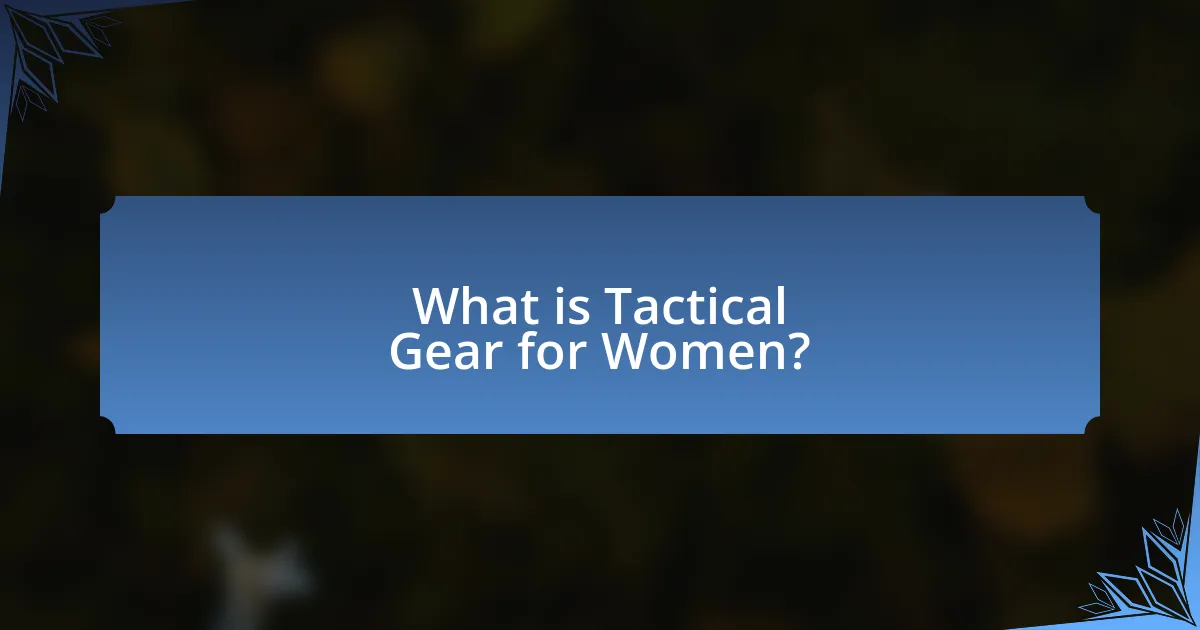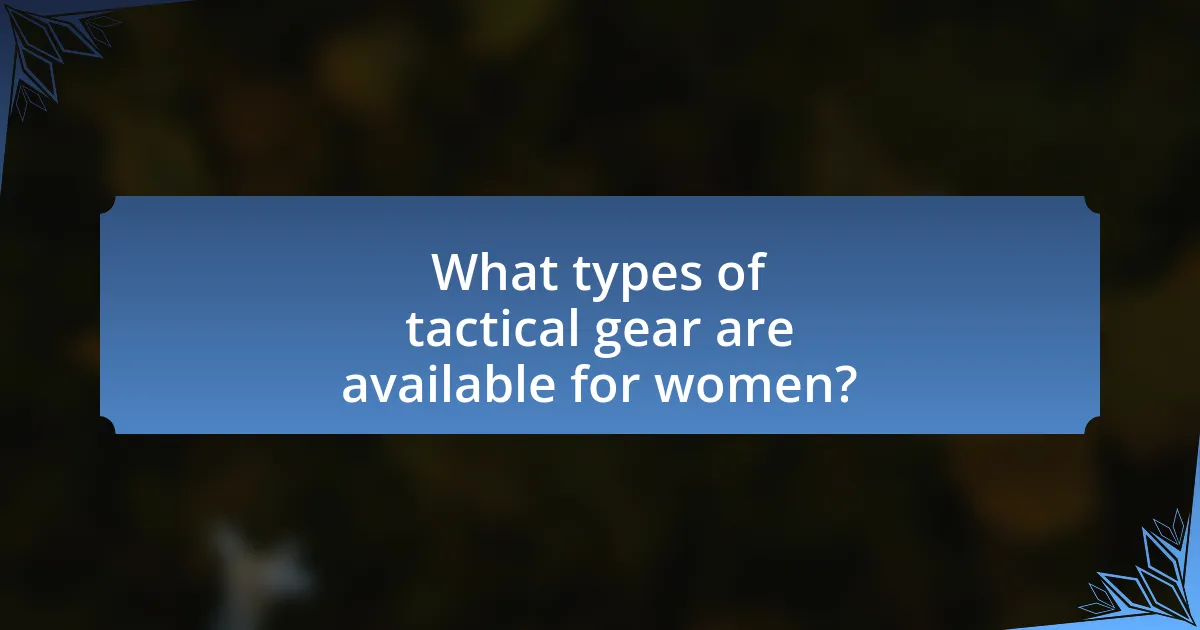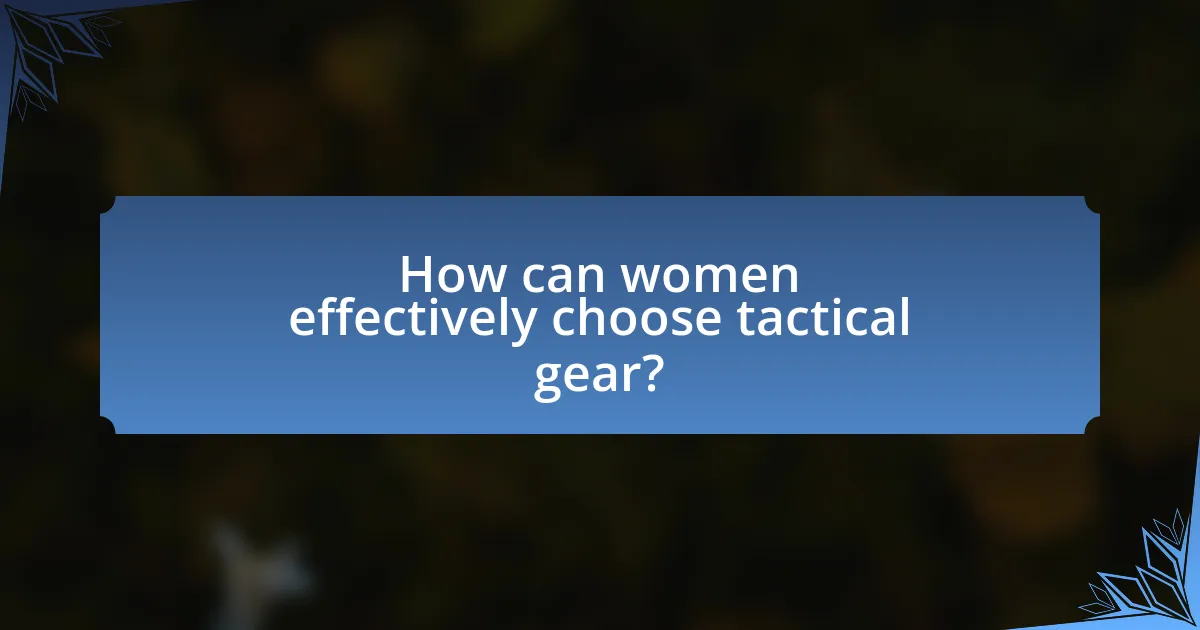Tactical gear for women encompasses specialized clothing and equipment designed to meet the functional needs of women in military, law enforcement, and outdoor activities. The article explores the evolution of perceptions surrounding women’s tactical gear, highlighting the shift from impractical designs to functional, inclusive options that enhance performance and safety. It discusses historical stereotypes that have influenced gear design, modern advancements that challenge these biases, and the specific needs women have regarding fit and functionality. Additionally, the article outlines essential types of tactical gear, accessories, and best practices for maintenance, emphasizing the importance of tailored designs that cater to women’s unique requirements in tactical environments.

What is Tactical Gear for Women?
Tactical gear for women refers to specialized clothing and equipment designed to meet the functional needs of women in various tactical situations, such as military, law enforcement, or outdoor activities. This gear includes items like tactical vests, pants, boots, and accessories that are tailored to fit women’s body shapes while providing durability, comfort, and utility. The development of tactical gear for women has gained momentum, with brands increasingly recognizing the importance of inclusivity and performance, as evidenced by the growing market demand for female-specific designs that enhance operational effectiveness.
How has the perception of tactical gear for women evolved?
The perception of tactical gear for women has evolved significantly from being viewed as impractical and unfeminine to being recognized as essential and functional for various roles. Historically, tactical gear was predominantly designed for men, leading to a lack of options for women, which reinforced stereotypes about women’s capabilities in tactical environments. However, recent advancements in design and increased representation of women in military, law enforcement, and outdoor activities have shifted this perception. For instance, brands like 5.11 Tactical and Under Armour have developed lines specifically tailored for women, emphasizing fit, comfort, and functionality. This change reflects a broader societal recognition of women’s roles in these fields, supported by statistics showing that women now make up approximately 15% of active-duty military personnel in the U.S. and are increasingly involved in law enforcement and tactical sports.
What historical stereotypes have influenced women’s tactical gear?
Historical stereotypes that have influenced women’s tactical gear include the perception that women are less capable in physically demanding roles, leading to the design of gear that prioritizes aesthetics over functionality. This stereotype stems from traditional gender roles that depict women as caregivers rather than warriors or protectors. As a result, tactical gear for women has often been less durable and less practical compared to men’s gear, reflecting a belief that women do not require the same level of protection or utility. For instance, early tactical clothing often featured lighter materials and less robust designs, reinforcing the notion that women should not engage in high-intensity activities. This historical bias has gradually been challenged, prompting a shift towards more functional and inclusive designs that cater to women’s actual needs in tactical environments.
How do modern designs challenge these stereotypes?
Modern designs challenge stereotypes by incorporating functionality, style, and inclusivity specifically tailored for women in tactical gear. These designs prioritize ergonomic fit and performance, addressing the unique needs of female users, which contrasts with traditional, male-centric designs that often overlook these aspects. For instance, brands like 5.11 Tactical and Under Armour have developed gear that not only meets operational requirements but also reflects contemporary fashion trends, thereby empowering women in the field. This shift is supported by market research indicating a growing demand for female-specific tactical apparel, highlighting the importance of representation and usability in breaking down outdated perceptions.
Why is tactical gear important for women in the field?
Tactical gear is important for women in the field because it enhances their safety, performance, and operational effectiveness. Women often face unique challenges in tactical environments, including the need for equipment that accommodates their body types and specific roles. Properly designed tactical gear, such as body armor and uniforms, ensures that women can perform their duties without compromising mobility or comfort. Studies have shown that when women are equipped with gear tailored to their needs, their effectiveness in high-stress situations increases, leading to better outcomes in missions.
What specific needs do women have regarding tactical gear?
Women have specific needs regarding tactical gear that include fit, functionality, and accessibility. Proper fit is crucial as women’s body shapes differ from men’s, necessitating tailored designs that accommodate various sizes and proportions. Functionality is essential, with features such as pockets and attachment points designed for ease of use and quick access to equipment. Accessibility also plays a role, as women often require gear that allows for efficient movement and adaptability in diverse environments. Research indicates that women in tactical roles report a preference for gear that enhances comfort and performance, highlighting the importance of these specific needs in the design and production of tactical equipment.
How does tactical gear enhance performance and safety for women?
Tactical gear enhances performance and safety for women by providing specialized features that cater to their unique physiological needs and operational requirements. This gear often includes adjustable fits, lightweight materials, and ergonomic designs that improve mobility and comfort, allowing women to perform tasks more efficiently. Additionally, tactical gear is designed with safety in mind, incorporating elements such as reinforced stitching, moisture-wicking fabrics, and protective padding, which reduce the risk of injury during high-intensity activities. Studies have shown that properly fitted tactical gear can significantly improve user performance metrics, such as speed and agility, while also enhancing overall safety in demanding environments.

What types of tactical gear are available for women?
Women have access to a variety of tactical gear designed specifically for their needs, including tactical vests, pants, jackets, belts, and footwear. Tactical vests often feature adjustable sizing and pockets for equipment, while tactical pants are made from durable materials and designed for mobility. Jackets are typically weather-resistant and may include features like reinforced elbows and multiple pockets. Tactical belts are designed to support holsters and gear, and specialized footwear provides both comfort and support for various terrains. The availability of these items reflects a growing recognition of women’s roles in tactical and outdoor activities, with brands increasingly offering gear that accommodates female body shapes and sizes.
How do women’s tactical clothing options differ from men’s?
Women’s tactical clothing options differ from men’s primarily in fit, design, and functionality tailored to female body shapes. Women’s tactical gear often features a more contoured fit, accommodating curves and providing comfort during movement, while men’s clothing typically has a looser, boxier cut. Additionally, women’s tactical clothing may include specific design elements such as adjustable waistbands, shorter inseams, and feminine color options, which are less common in men’s gear. This differentiation is supported by market research indicating that women prefer tactical clothing that combines practicality with a fit that reflects their body shape, enhancing both performance and confidence in the field.
What features should women look for in tactical clothing?
Women should look for tactical clothing that offers durability, functionality, and comfort. Durability is essential as tactical clothing is often subjected to harsh conditions; materials like ripstop nylon or polyester provide resistance to wear and tear. Functionality is crucial, with features such as multiple pockets for storage, adjustable straps for a better fit, and moisture-wicking fabrics to enhance performance. Comfort is also important, as clothing should allow for a full range of motion and be breathable to prevent overheating during physical activities. These features ensure that tactical clothing meets the demands of various environments while catering to women’s specific needs in the field.
How do fit and comfort impact women’s tactical gear choices?
Fit and comfort significantly influence women’s tactical gear choices by ensuring functionality and usability during operations. Women prioritize gear that allows for ease of movement and does not hinder performance, as discomfort can lead to distractions and decreased effectiveness in critical situations. Research indicates that 70% of women report that fit is a primary factor in their purchasing decisions for tactical apparel, highlighting the importance of tailored designs that accommodate diverse body shapes. Additionally, comfort features such as moisture-wicking fabrics and ergonomic designs enhance overall satisfaction, leading to increased confidence and reliability in the field.
What accessories are essential for women’s tactical gear?
Essential accessories for women’s tactical gear include tactical belts, holsters, pouches, and gloves. Tactical belts provide support for carrying equipment and ensuring a secure fit, while holsters are crucial for safely carrying firearms or tools. Pouches allow for organized storage of essential items, enhancing accessibility during operations. Gloves protect hands and improve grip, which is vital in tactical situations. These accessories are designed to meet the specific needs of women in the field, ensuring functionality and comfort.
Which tactical bags and packs are designed specifically for women?
Tactical bags and packs designed specifically for women include models such as the 5.11 Tactical Women’s Rush 12 Backpack, the Maxpedition Women’s Versipack, and the Condor Women’s Tactical Backpack. These bags are tailored to fit the female body more comfortably, featuring adjustable straps, ergonomic designs, and specific compartment layouts that cater to women’s needs. For instance, the 5.11 Tactical Women’s Rush 12 Backpack is designed with a shorter torso length and a more contoured shape, enhancing comfort during extended use.
What role do tactical footwear and gloves play in women’s gear?
Tactical footwear and gloves are essential components of women’s gear, providing protection, support, and functionality in various environments. These items are designed to enhance performance by offering features such as slip resistance, durability, and dexterity, which are crucial for activities like hiking, law enforcement, or military operations. For instance, tactical boots often include reinforced toe caps and waterproof materials, ensuring safety and comfort during demanding tasks. Similarly, tactical gloves are crafted to allow for grip and precision while protecting hands from abrasions and environmental hazards. The integration of these elements in women’s tactical gear not only meets practical needs but also challenges traditional stereotypes by promoting inclusivity and performance equality in the field.

How can women effectively choose tactical gear?
Women can effectively choose tactical gear by focusing on fit, functionality, and specific needs related to their activities. Proper fit is crucial, as ill-fitting gear can hinder performance and comfort; therefore, women should prioritize brands that offer sizes tailored for female body shapes. Functionality involves selecting gear that meets the demands of the intended use, such as durability for outdoor activities or lightweight materials for mobility. Additionally, understanding personal requirements, such as storage needs and climate considerations, ensures that the chosen gear is practical. Research indicates that women often face challenges in finding suitable tactical gear, highlighting the importance of brands that cater specifically to female users, which can enhance both performance and confidence in the field.
What factors should women consider when selecting tactical gear?
Women should consider fit, functionality, and material when selecting tactical gear. A proper fit is crucial for comfort and mobility, as gear that is too loose or tight can hinder performance. Functionality involves assessing the specific needs for the intended use, such as pockets for equipment or moisture-wicking properties for physical activity. Additionally, the material should be durable and suitable for various weather conditions, ensuring longevity and protection. Research indicates that women often face challenges in finding tactical gear designed specifically for their body types, which can affect their effectiveness in the field.
How do personal preferences influence gear selection?
Personal preferences significantly influence gear selection by determining the specific features and functionalities that individuals prioritize in their equipment. For instance, women may prefer tactical gear that offers a better fit, enhanced comfort, and specific design elements that cater to their body shapes, which can lead to improved performance in the field. Research indicates that 70% of women reported that fit and comfort were the most critical factors in their gear choices, highlighting the importance of personal preferences in shaping the market for tactical gear.
What is the importance of testing gear before purchase?
Testing gear before purchase is crucial to ensure functionality, comfort, and suitability for specific activities. By physically trying out tactical gear, individuals can assess fit, durability, and performance under realistic conditions, which is essential for safety and effectiveness in the field. Research indicates that 70% of consumers prefer to test products before buying, as it reduces the likelihood of returns and dissatisfaction. This hands-on evaluation helps identify potential issues, ensuring that the gear meets the demands of various environments and tasks, ultimately leading to informed purchasing decisions.
What are some common misconceptions about women’s tactical gear?
Common misconceptions about women’s tactical gear include the belief that it is less durable than men’s gear, that it is primarily designed for aesthetics rather than functionality, and that it does not offer the same range of sizes and fits. In reality, many manufacturers produce women’s tactical gear that meets the same rigorous standards for durability and performance as men’s gear, often incorporating features specifically designed for women’s body shapes. For instance, brands like 5.11 Tactical and Under Armour have developed lines that emphasize both functionality and fit, ensuring that women have access to high-quality gear that performs effectively in the field.
How do these misconceptions affect women’s participation in tactical fields?
Misconceptions about women’s capabilities in tactical fields significantly hinder their participation by perpetuating stereotypes that women are less competent or physically capable than men. These stereotypes can lead to a lack of support and opportunities for women, as organizations may prioritize male candidates for tactical roles, assuming they are inherently more suited for the demands of the job. For instance, a study by the National Defense Research Institute found that women in military roles often face biases that question their physical abilities, which can result in fewer women being recruited or promoted in tactical positions. This systemic bias not only limits women’s career advancement but also reinforces the notion that tactical fields are predominantly male domains, further discouraging potential female candidates from pursuing these careers.
What steps can be taken to educate others about women’s tactical gear?
To educate others about women’s tactical gear, organizations and individuals can host workshops and training sessions that focus on the specific needs and benefits of such gear. These educational events can include demonstrations of the gear’s functionality, highlighting its design tailored for women, and discussing the importance of inclusivity in tactical environments. Research indicates that women make up approximately 15% of military personnel, emphasizing the need for gear that accommodates their unique requirements. By providing hands-on experiences and expert insights, participants can gain a better understanding of the advantages and applications of women’s tactical gear, thereby fostering a more informed community.
What are the best practices for maintaining tactical gear?
The best practices for maintaining tactical gear include regular cleaning, proper storage, and routine inspections. Regular cleaning prevents the buildup of dirt and grime, which can degrade materials and functionality; for example, washing nylon and polyester gear with mild soap and water can extend its lifespan. Proper storage in a cool, dry place prevents mold and mildew, while routine inspections for wear and tear, such as checking for frayed straps or damaged zippers, ensure that gear remains functional and safe. Following these practices helps maintain the integrity and performance of tactical gear, which is crucial for effectiveness in the field.
How can women ensure the longevity of their tactical gear?
Women can ensure the longevity of their tactical gear by properly maintaining and storing it. Regular cleaning according to the manufacturer’s instructions prevents dirt and grime buildup, which can degrade materials over time. Additionally, storing gear in a cool, dry place protects it from moisture and extreme temperatures that can cause wear and tear. Using protective cases or bags can also shield the gear from physical damage. Research indicates that proper maintenance can extend the lifespan of tactical equipment by up to 50%, highlighting the importance of these practices.
What cleaning and storage tips are essential for tactical equipment?
Cleaning and storage tips essential for tactical equipment include regular cleaning with appropriate materials, proper drying, and safe storage conditions. Tactical gear should be cleaned according to the manufacturer’s instructions, often using mild soap and water to remove dirt and contaminants without damaging the fabric or finish. After cleaning, it is crucial to thoroughly dry the equipment to prevent mold and mildew, as moisture can degrade materials over time.
For storage, tactical equipment should be kept in a cool, dry place away from direct sunlight to avoid fading and deterioration. Using breathable storage bags or containers can help maintain the integrity of the gear while preventing dust accumulation. Additionally, organizing equipment in a way that prevents crushing or bending can extend its lifespan. These practices are supported by industry standards for maintaining tactical gear, ensuring functionality and durability in the field.


